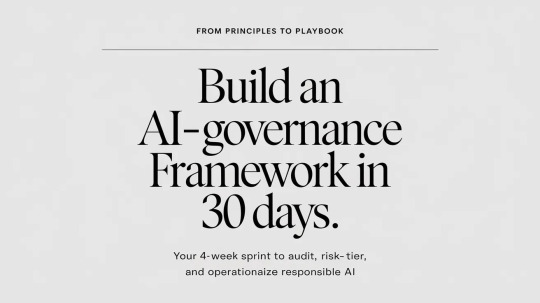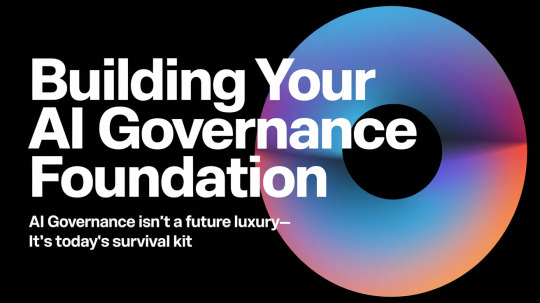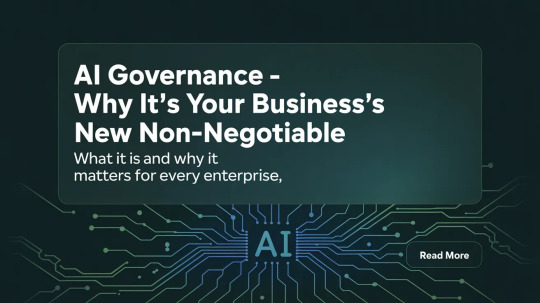Enterprise AI adoption empowers organizations to integrate artificial intelligence into core operations, driving efficiency, innovation, and data-driven decision-making. Visit the site for more insights: https://www.natepatel.com/
Don't wanna be here? Send us removal request.
Text

The gap between aspirational AI principles and operational reality is where risks fester — ethical breaches, regulatory fines, brand damage, and failed deployments. Waiting for perfect legislation or the ultimate governance tool isn’t a strategy; it’s negligence. The time for actionable governance is now.
This isn’t about building an impenetrable fortress overnight. It’s about establishing a minimum viable governance (MVG) framework — a functional, adaptable system — within 30 days. This article is your tactical playbook to bridge the principles-to-practice chasm, mitigate immediate risks, and lay the foundation for robust, scalable AI governance.
Why 30 Days? The Urgency Imperative
Accelerating Adoption: AI use is exploding organically across departments. Without guardrails, shadow AI proliferates.
Regulatory Tsunami: From the EU AI Act and US Executive Orders to sector-specific guidance, compliance deadlines loom.
Mounting Risks: Real-world incidents (biased hiring tools, hallucinating chatbots causing legal liability, insecure models leaking data) demonstrate the tangible costs of inaction.
Competitive Advantage: Demonstrating trustworthy AI is becoming a market differentiator for customers, partners, and talent.
Read More: From Principles to Playbook: Build an AI-Governance Framework in 30 Days
- Nate Patel
Read More Articles:
Building Your AI Governance Foundation
AI Governance: Why It’s Your Business’s New Non-Negotiable
0 notes
Text
The Foundation: The Four Pillars of Operational AI Governance | Nate Patel
An effective MVG framework isn't a single document; it's an integrated system resting on four critical pillars. Neglect any one, and the structure collapses.

Policy Pillar: The "What" and "Why" - Setting the Rules of the Road
Purpose: Defines the organization's binding commitments, standards, and expectations for responsible AI development, deployment, and use.
Core Components:
Risk Classification Schema: A clear system for categorizing AI applications based on potential impact (e.g., High-Risk: Hiring, Credit Scoring, Critical Infrastructure; Medium-Risk: Internal Process Automation; Low-Risk: Basic Chatbots). This dictates the level of governance scrutiny. (e.g., Align with NIST AI RMF or EU AI Act categories).
Core Mandatory Requirements: Specific, non-negotiable obligations applicable to all AI projects. Examples:
Human Oversight: Define acceptable levels of human-in-the-loop, on-the-loop, or review for different risk classes.
Fairness & Bias Mitigation: Requirements for impact assessments, testing metrics (e.g., demographic parity difference, equal opportunity difference), and mitigation steps.
Transparency & Explainability: Minimum standards for model documentation (e.g., datasheets, model cards), user notifications, and explainability techniques required based on risk.
Robustness, Safety & Security: Requirements for adversarial testing, accuracy thresholds, drift monitoring, and secure
Read More: From Principles to Playbook: Build an AI-Governance Framework in 30 Days
Read More Articles:
Building Your AI Governance Foundation
AI Governance: Why It’s Your Business’s New Non-Negotiable
— Nate Patel
Follow Nate Patel for More on AI Strategy and Ethical Innovation:
🔹 LinkedIn: linkedin.com/in/npofc
🔹 X (formerly Twitter): x.com/npatelofc
🔹 Instagram: instagram.com/natepatel.aicpto
Stay connected to discover the latest in AI insights, enterprise strategy, and future-focused keynotes.
0 notes
Text

Building Your AI Governance Foundation | Nate Patel
AI governance isn’t a future luxury—it’s today’s survival kit. Before regulations lock in and risks snowball, lay down a pragmatic framework that inventories every model, assigns accountable owners, embeds proven standards (NIST, ISO/IEC 42001), and hard-wires continuous monitoring. The action plan below shows how to move from scattered experiments to a disciplined, risk-tiered governance foundation—fast.
Waiting for perfect regulations or tools is a recipe for falling behind. Start pragmatic, start now, and scale intelligently.
Key Steps:
Audit & Risk-Assess Existing AI: Don't fly blind.
Inventory: Catalog all AI/ML systems in use or development (including "shadow IT" and vendor-provided AI).
Risk Tiering: Classify each system based on potential impact using frameworks like the EU AI Act categories (Unacceptable, High, Limited, Minimal Risk). Focus first on High-Risk applications (e.g., HR, lending, healthcare, critical infrastructure, law enforcement). What's the potential harm if it fails (bias, safety, security, financial)?
Assign Clear Ownership & Structure: Governance fails without accountability.
Establish an AI Governance Council: A cross-functional team is non-negotiable. Include senior leaders from:
Legal & Compliance: Regulatory navigation, contractual risks.
Technology/Data Science: Technical implementation, tooling, model development standards.
Ethics/Responsible AI Office: Championing fairness, societal impact, ethical frameworks.
Risk Management: Holistic risk assessment and mitigation.
Business Unit Leaders: Ensuring governance supports business objectives and usability.
Read More: Building Your AI Governance Foundation
- Nate Patel
Read More Articles:
From Principles to Playbook: Build an AI-Governance Framework in 30 Days
AI Governance: Why It’s Your Business’s New Non-Negotiable
0 notes
Text

Nate Patel | Enterprise AI Strategist | AI Consulting & Digital Transformation | Keynote Speaker | Responsible AI Advisor
Nate Patel is a distinguished AI strategist, consultant, and keynote speaker renowned for guiding enterprises through responsible AI adoption and digital transformation. With deep expertise in ethical AI governance, scalable solution design, and strategic implementation, he helps organizations align innovation with business objectives and human-centric values. His pragmatic frameworks—from principles to playbooks—enable teams to govern, iterate, and embed AI systems that deliver real impact. Nate’s work spans industries, delivering growth, efficiency, and trust. He frequently speaks at global conferences and contributes thought leadership to shape responsible AI ecosystems. Explore his insights, services, and frameworks at natepatel.com.
#nate patel#nate#enterprise ai adoption#ai business consulting#ai consulting usa#ai digital transformation services#ai keynote speaker#ai strategy consultant
0 notes
Text
Nate Patel is a seasoned AI strategist and digital transformation leader, guiding enterprises in responsible AI adoption, governance, and scalable innovation. He partners with organizations to design ethics-driven AI frameworks that deliver real business value. Learn more about his expertise and services at https://www.natepatel.com.
#nate patel#enterprise ai adoption#ai business consulting#ai consulting usa#ai digital transformation services#ai keynote speaker#responsible ai framework Advisor#ai strategy consultant
0 notes
Text
What AI Governance Really Is (Demystified) | Nate Patel

Forget vague principles. AI governance is the practical, end-to-end framework ensuring AI systems are lawful, ethical, safe, and effective—from initial design and training to deployment, monitoring, and eventual decommissioning. It translates lofty ideals into concrete actions and accountability.
Core Components: The Pillars of Responsible AI:
Accountability: Clear ownership is paramount. Who answers when the AI fails catastrophically? Governance mandates defined roles and responsibilities for every stage of the AI lifecycle (e.g., data scientists, product owners, legal, C-suite). This includes documented decision trails and escalation paths.
Transparency & Explainability: Can you meaningfully explain how your AI arrived at a critical decision to a regulator, customer, or judge? This isn't just about technical "black box" interpretability, but about providing auditable reasons understandable to stakeholders. This is non-negotiable under regulations like the EU AI Act.
Fairness & Bias Mitigation: Proactively identifying and minimizing discriminatory outcomes is critical, especially in high-stakes domains like hiring, lending, healthcare diagnostics, and law enforcement. This involves rigorous testing on diverse datasets throughout development and monitoring for drift in production.
Robustness, Safety & Security: AI systems must perform reliably under diverse conditions and be resilient against attacks. Governance ensures rigorous testing for vulnerabilities (e.g., adversarial attacks, data poisoning) and establishes protocols for safe failure modes. Protecting the model itself as critical IP is also key.
Read More: What AI Governance Really Is?
- Nate Patel
Read More Articles:
Building Your AI Governance Foundation
From Principles to Playbook: Build an AI-Governance Framework in 30 Days
0 notes